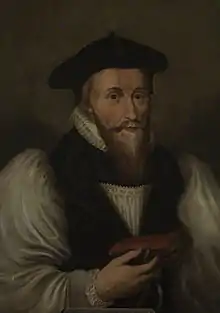James Montague (bishop)
James Montague (c. 1568 – 20 July 1618) was an English bishop.[2]
James Montague | |
|---|---|
| Bishop of Winchester | |
 | |
| Diocese | Diocese of Winchester |
| In office | 1616 (translation)–1618 (death) |
| Predecessor | Thomas Bilson |
| Successor | Lancelot Andrewes |
| Other posts | Master of Sidney Sussex (1596–1608) Dean of the Chapel Royal (1603–1618) Dean of Lichfield (1603–1604) Dean of Worcester (1604–1608) Bishop of Bath and Wells (1608–1616) privy counsellor (October 1617–1618) |
| Personal details | |
| Born | 1568 Boughton, Northamptonshire, England |
| Died | 20 July 1618 (aged 49–50) Greenwich, Kent, England |
| Buried | Greenwich (bowels) 20 August 1618, Bath Abbey (body) |
| Nationality | English |
| Denomination | Anglican |
| Parents | Sir Edward Montague of Boughton & Elizabeth (née Harington of Exton), Lady Montague |
| Alma mater | Christ's College, Cambridge |
Ordination history of James Montague | |||||||||||||
|---|---|---|---|---|---|---|---|---|---|---|---|---|---|
| |||||||||||||
| Source(s):[1] | |||||||||||||
Life
He was the son of Sir Edward Montagu of Boughton, and grandson of Edward Montagu.[3]
He was a graduate of Christ's College, Cambridge, and became in 1596 the first Master of Sidney Sussex College, Cambridge, for which he laid the foundation stone.[4] He was connected to Frances Sidney, founder of the college, his great-aunt: his maternal grandmother was her sister Lucy Sidney.[5] From that time he was a patron of Thomas Gataker. In 1603 he became Dean of the Chapel Royal.[6][7][8] Montague was both a courtier and a Calvinist, and closer to the king than George Abbot, Archbishop of Canterbury; he is considered to have influenced James I against the Arminians.[9][10] With the other courtiers Sir Robert Darcy and John Harington, 1st Baron Harington of Exton, Montague introduced to court circles, and especially those around Henry Frederick, Prince of Wales, the Puritan Arthur Hildersham, and the radical religious figures Henry Jacob and John Burges.[11]
He edited the collected works of James I; it has been said that his introductions "push the art of panegyric close to deification".[12] He had worked with James on An Apologie for the Oath of Allegiance in 1607, at Royston and Newmarket, reading to James the four volumes of the works of Cardinal Bellarmine.[13][14]
He was Dean of Lichfield from July 1603 until he became Dean of Worcester on 20 December 1604. Montague was elected Bishop of Bath and Wells on 29 March 1608,[15] his election was confirmed on 15 April[16] and he was enthroned and installed at Wells Cathedral on 14 May 1608;[17] he was translated to become Bishop of Winchester on 3 July 1616.[18] At Bath and Wells, he contributed to the legend of the Holy Thorn of Glastonbury, in an entertainment for Anne of Denmark, when the character of Joseph of Arimathea presented boughs to the Queen.[19] He is buried in an alabaster tomb in Bath Abbey.[20]
References
- Appointment Record: Montague, James (at Bath and Wells) in "CCEd, the Clergy of the Church of England database" (Accessed online, 29 March 2015)
- . Dictionary of National Biography. London: Smith, Elder & Co. 1885–1900.
- "James MONTAGUE (Bishop of Winchester)". tudorplace.com.ar. Retrieved 12 April 2014.
- "Montagu, James (MNTG585J)". A Cambridge Alumni Database. University of Cambridge.
- "HARRINGTON". tudorplace.com.ar. Retrieved 12 April 2014.
- "The colleges and halls - Sidney Sussex | A History of the County of Cambridge and the Isle of Ely: Volume 3 (pp. 481-487)". british-history.ac.uk. Retrieved 12 April 2014.
- Peter Le Huray, Music and the Reformation in England, 1549–1660 (1978), p. 59.
- "Gataker_Marriage_Duties_Biography". usask.ca. Retrieved 12 April 2014.
- Nicholas Tyacke, Lancelot Andrewes and the Myth of Anglicanism, p. 29 in Peter Lake, Michael C. Questier (editors), Conformity and Orthodoxy in the English Church, c. 1560 – 1660 (2000).
- Ralph Anthony Houlbrooke, James VI and I: Ideas, Authority, and Government (2006), p. 173.
- Christopher Hill, Intellectual Origins of the English Revoluation (1965), p. 217.
- Graham Parry, The Golden Age Restor'd: The Culture of the Stuart Court 1603–1642 (1981), p. 26.
- Alan Stewart, The Cradle King: A Life of James VI & I (2003), p. 227.
- Doris Jones-Baker, Hertfordshire in History: Papers Presented to Lionel Munby (2004), p. 99.
- Appointment Record: Montague, James (at Bath and Wells) in "CCEd, the Clergy of the Church of England database" (Accessed online, 29 March 2015)
- Appointment Record: Montague, James (at Bath and Wells) in "CCEd, the Clergy of the Church of England database" (Accessed online, 29 March 2015)
- Appointment Record: Montague, James (at Bath and Wells) in "CCEd, the Clergy of the Church of England database" (Accessed online, 29 March 2015)
- Concise Dictionary of National Biography
- "Isle of Avalon | the History of Glastonbury". isleofavalon.co.uk. Retrieved 12 April 2014.
- "Bath Abbey: Places to visit in Bath". historicbritain.com. Retrieved 12 April 2014.
Sources
- "Montagu, James". Oxford Dictionary of National Biography (online ed.). Oxford University Press. doi:10.1093/ref:odnb/19021. (Subscription or UK public library membership required.)
| Academic offices | ||
|---|---|---|
| New title | Master of Sidney Sussex College, Cambridge 1596–1608 |
Succeeded by Francis Aldrich |
| Church of England titles | ||
| Preceded by John Still |
Bishop of Bath and Wells 1608–1616 |
Succeeded by Arthur Lake |
| Preceded by Thomas Bilson |
Bishop of Winchester 1616–1618 |
Succeeded by Lancelot Andrewes |
